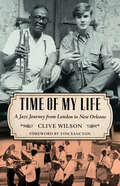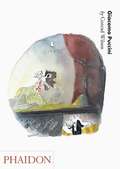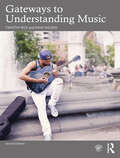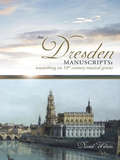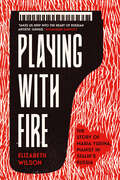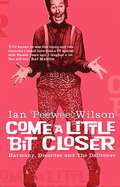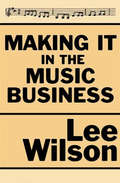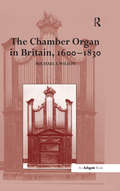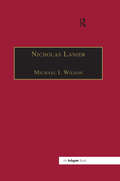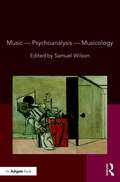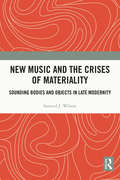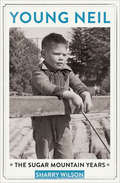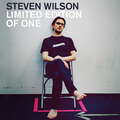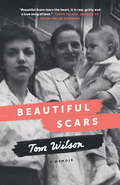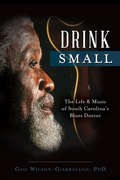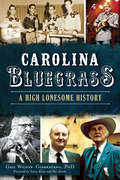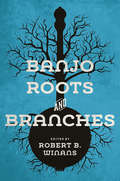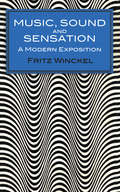- Table View
- List View
Time of My Life: A Jazz Journey from London to New Orleans (American Made Music Series)
by Clive WilsonNew Orleans is a kind of Mecca for jazz pilgrims, as Whitney Balliett once wrote. This memoir tells the story of one aspiring pilgrim, Clive Wilson, who fell in love with New Orleans jazz in his early teens while in boarding school in his native England. It is also his story of gradually becoming disenchanted with his family and English environment and, ultimately, finding acceptance and a new home in New Orleans.The timing of his arrival, at age twenty-two, just a few weeks after the signing of the 1964 Civil Rights Act and the end of legal segregation, placed him in a unique position with the mostly African American musicians in New Orleans. They showed him around, brought him into their lives, gave him music lessons, and even hired him to play trumpet in brass bands. In short, Wilson became more than a pilgrim; he became an apprentice, and for the first time, legally, in New Orleans, he could make that leap.Time of My Life: A Jazz Journey from London to New Orleans tells the story of Wilson’s journey as he discovers the contrast between his imagined New Orleans and its reality. Throughout, he delivers his impressions and interactions with such local musicians as “Fat Man” Williams, Manuel Manetta, Punch Miller, and Billie and DeDe Pierce. As his playing improves, invitations to play in local bands increase. Eventually, he joins in the jam and, by doing so, integrates the Original Tuxedo Jazz Band, which had been in continuous existence since 1911. Except for a brief epilogue, this memoir ends in 1979, when Wilson assembles his own band for the first time, the Original Camellia Jazz Band, with musicians who had been among his heroes when he first arrived in New Orleans.
Giacomo Puccini
by Conrad WilsonGiacomo Puccini (1858--1924), composer of such popular operas as La Bohème and Madame Butterfly, is most renowned for his gift as a melodist. With his final opera, Turandot, Puccini composed the last Italian work in the genre to hold a firm place in the international repertoire. The author draws attention to the felicity, daring and extraordinary colouring of his music, countering the view held during Puccini's lifetime that he was a retrogressive who aimed to shock. Puccini is shown to have been a new force in musical drama, and yet a man who remained insecure about his creative powers. Conrad Wilson's book is a polemical, passionate and rational attempt to set the man from Lucca among the immortal greats.
Gateways to Understanding Music
by Dave Wilson Timothy RiceGateways to Understanding Music, Second Edition, explores music in all the categories that constitute contemporary musical experience: European classical, popular, jazz, and world music. Covering the oldest forms of human music making to the newest, this chronology presents music from a global rather than a Eurocentric perspective. Each of 60 "gateways" addresses a particular genre, style, or period of music. Every gateway opens with a guided listening example that unlocks a world of music through careful study of its structural elements. How did the piece come to be composed or performed? How did it respond to the social and cultural issues at the time, and what does that music mean today? Students learn to listen to, explain, understand, and ultimately value all the music they encounter in their world. New to this edition is a broader selection of musical examples that reflect the values of diversity, equity, and inclusion advocated by North American universities. Eight gateways have been replaced. A timeline of gateways helps students see the book’s historical narrative at a glance. Features Values orientation—Diverse, equitable, and inclusive approach to music history. All genres of music—Presents all music as worthy of study, including classical, world, popular, and jazz. Global scope within a historical narrative—Begins with small-scale forager societies up to the present, with a shifting focus from global to European to American influences. Recurring themes — Aesthetics, emotion, social life, links to culture, politics, economics, and technology. Modular framework—60 gateways—each with a listening example—allow flexibility to organize chronologically or by the seven themes. Consistent structure—With the same step-by-step format, students learn through repeated practice how to listen and how to think about music. Anthology of scores—For those courses that use the textbook in a music history sequence. Gateways to Understanding Music continues to employ a website to host the audio examples and instructor’s resources.
The Dresden Manuscripts: Unearthing an 18th Century Musical Genius
by David WilsonA lifelong study of the music of Johann Hasse by conductor David Wilson has culminated in his superb new book, The Dresden Manuscripts: Unearthing an 18th Century Musical Genius. Hasse's music achieved great popularity during his lifetime, only to be overshadowed later in history by other composers, especially Mozart. Dr. Wilson's important and illuminating focus on the Dresden manuscripts will certainly be a springboard for conductors and musicologists to further examine the entirety of Hasse's oeuvre to rediscover other gems, particularly among the masses and operas, many of which will be found worthy of reentering the repertoire. David Wilson has produced a revelatory work of refined scholarship that will deepen our knowledge of this important yet oft-neglected Baroque composer.
Playing with Fire: The Story of Maria Yudina, Pianist in Stalin's Russia
by Elizabeth WilsonThe first full biography of the fearless and brilliant Maria Yudina, a legendary pianist who was central to Russian intellectual life Maria Yudina was no ordinary musician. An incredibly popular pianist, she lived on the fringes of Soviet society and had close friendships with such towering figures as Boris Pasternak, Pavel Florensky, and Mikhail Bakhtin. Legend has it that she was Stalin&’s favorite pianist. Yudina was at the height of her fame during WWII, broadcasting almost daily on the radio, playing concerts for the wounded and troops in hospitals and on submarines, and performing for the inhabitants of besieged Leningrad. By the last years of her life, she had been dismissed for ideological reasons from the three institutions where she taught. And yet according to Shostakovich, Yudina remained &“a special case. . . . The ocean was only knee-deep for her.&” In this engaging biography, Elizabeth Wilson sets Yudina&’s extraordinary life within the context of her times, where her musical career is measured against the intense intellectual and religious ferment of the post-revolutionary period and the ensuing years of Soviet repression.
Shostakovich: A Life Remembered
by Elizabeth WilsonShostakovich: A Life Remembered is a unique study of the great composer Dimitri Shostakovich drawn from the reminiscences and reflections of his contemporaries. Using much material never previously published in English, as well as personal accounts from interviews and specially commissioned articles, Elizabeth Wilson has built a fascinating chronicle of Shostakovich's life.
Come a Little Bit Closer
by Ian WilsonIan 'Peewee' Wilson has been singing bass doo-wop with iconic vocal group The Delltones since the 1950s and the First Wave of Australian pop. In this breezy and brilliant memoir, Peewee recalls the highs and inimitable lows of life fronting Australia's longest-performing vocal group. Beyond the stage door he reveals the secret to his longevity: a larrikin spirit honed in his beach-bumming youth, and a wide-eyed curiosity that led him to dabble in hallucinogenic substances and chase Playboy Bunnies (not at the same time). It's all part of Peewee's never-ending search for the underlying meaning of it all. Come a little bit closer to the Beanpole of Bop.
Making It in the Music Business: The Business and Legal Guide for Songwriters and Performers
by Lee WilsonFrom an experienced entertainment lawyer, &“a terrific handbook that outlines all the information a fledgling musician or songwriter needs to know&” (Booklist). Early in their careers, most musicians find it hard to believe that their band might ever make enough money to fight over. But sooner than you think, success may arrive, and without clear terms that spell out how the band is organized and who controls what rights, your best friends and fellow musicians may become your worst enemies. Anyone who seeks to enter the complex world of the music business ought to know what to do in order to avoid derailing a high-speed ride to the top of the charts. This guide from a longtime intellectual property lawyer can help you get there—without breaking up the band.
The Chamber Organ in Britain, 1600-1830
by Michael I. WilsonThe first edition of The English Chamber Organ was published in 1968. This new, revised edition takes into account the considerable research into chamber organs that has taken place over the last thirty years. Much of the book has been completely rewritten and expanded, and it includes a number of organs not detailed in the first edition. As its revised title suggests, this new edition covers foreign-make imports as well as British-made organs that were sent overseas. Part one comprises a series of chapters that cover the history of the chamber organ, its origins and development. Part two provides a general introduction to the construction of organs, while part three gives detailed descriptions of 196 British chamber organs, with information on their location, specifications, design, and suggestions for further reading. As a domestic instrument the chamber organ was often perceived to be as much a piece of furniture as an item of musical equipment. The Chamber Organ in Britain offers an assessment of the organ as both a musical instrument and as a decorative icon.
Nicholas Lanier: Master of the King's Musick
by MichaelI. WilsonNicholas Lanier (1588-1666) was not only the first person to hold the office of Master of the Music to King Charles I, he was also a practising painter, a friend of Rubens, Van Dyck and many other artists of his time, and one of the very first great art collectors and connoisseurs. He is especially remembered for the part he played in acquiring, on behalf of Charles I, the famous collection of paintings belonging to the Gonzaga family of Mantua. Many of these paintings still form an important part of the Royal Collection today. In this book the different strands of Lanier's colourful life are for the first time drawn together and presented in a single compelling narrative.
Music—Psychoanalysis—Musicology
by Samuel WilsonThere is a growing interest in what psychoanalytic theory brings to studying and researching music. Bringing together established scholars within the field, as well as emerging voices, this collection outlines and advances psychoanalytic approaches to our understanding of a range of musics—from the romantic and the modernist to the contemporary popular. Drawing on the work of Freud, Lacan, Jung, Žižek, Barthes, and others, it demonstrates the efficacy of psychoanalytic theories in fields such as music analysis, music and culture, and musical improvisation. It engages debates about both the methods through which music is understood and the situations in which it is experienced, including those of performance and listening. This collection is an invaluable resource for students, lecturers, researchers, and anyone else interested in the intersections between music, psychoanalysis, and musicology.
New Music and the Crises of Materiality: Sounding Bodies and Objects in Late Modernity
by Samuel WilsonThis book explores the transformation of ideas of the material in late twentieth- and early twenty-first-century musical composition. New music of this era is argued to reflect a historical moment when the idea of materiality itself is in flux. Engaging with thinkers such as Theodor Adorno, Sara Ahmed, Zygmunt Bauman, Rosi Braidotti, and Timothy Morton, the author considers music's relationship with changing material conditions, from the rise of neo-liberalisms and information technologies to new concepts of the natural world. Drawing on musicology, cultural theory, and philosophy, the author develops a critical understanding of musical bodies, objects, and the environments of their interaction. Music is grasped as something that both registers material changes in society whilst also enabling us to practice materiality differently. book focuses on how recent music and sound art have expressed notions of the body and the material environment. It engages with thinkers such as to demonstrate how this music relates to changing material conditions, from the
Young Neil: The Sugar Mountain Years
by Sharry Wilson&“A supremely compelling chronicle&” of Neil Young&’s early life (Rolling Stone). Covering the years from 1945 to 1966, this book documents the childhood and teenage life of Canadian musician and Rock & Roll Hall of Famer Neil Young. From his birth in Toronto through his school years in Florida, Ontario, and Manitoba, the book examines the development of Young&’s unique talent against a backdrop of shifting postwar values, a turbulent family history, and a musical revolution in the making—and includes many previously unseen photos and set lists. &“Not only takes us on Neil&’s voyage but also uncovers life in the 40&’s, 50&’s, and 60&’s in Ontario and Manitoba . . . Wonderful.&” —Bernie Finkelstein, author of True North: A Life In the Music Business &“Having covered Neil Young for a good portion of his career, I thought I knew everything there was to know about the man and his music. I was wrong. Sharry Wilson&’s book, marked by enormous depth of study and research, opens windows into Young&’s early life and creative development I never knew existed.&” —Dave Zimmer, author, Crosby, Stills & Nash: The Biography
Woodstock, Baby!: A Far-Out Counting Book
by Spencer WilsonA far-out counting board book celebrating the peace and love of Woodstock!Little rockers will love counting everything from peace signs and guitars to bell-bottoms and rock bands in this out-of-sight board book with simple rhyming words and groovy illustrations. It's the perfect gift for every little flower child and music fan.
Limited Edition of One
by Steven WilsonThe more I thought about it, the more I realised my career has been unusual. How did I manage to do everything wrong but still end up on the front cover of magazines, headlining world tours and achieving Top 5 albums? How did I attract such obsessive and fanatical fans, many of whom take everything I do or say very personally, which is simultaneously flattering but can also be tremendously frustrating? Even this I somehow cultivated without somehow meaning to. My accidental career.Limited Edition of One is unlike any other music book you will ever have read.Part the long-awaited memoir of Steven Wilson: whose celebrated band Porcupine Tree began as teenage fiction before unintentionally evolving into a reality that encompassed Grammy-nominated records and sold-out shows around the world, before he set out for an even more successful solo career.Part the story of a twenty-first century artist who achieved chart-topping mainstream success without ever becoming part of the mainstream. From Abba to Stockhausen, via a collection of conversations and thought pieces on the art of listening, the rules of collaboration, lists of lists, personal stories, professional adventurism (including food, film, TV, modern art), old school rock stardom, how to negotiate an obsessive fanbase and survive on social media, and dream-fever storytelling.
Limited Edition of One
by Steven WilsonThe more I thought about it, the more I realised my career has been unusual. How did I manage to do everything wrong but still end up on the front cover of magazines, headlining world tours and achieving Top 5 albums? How did I attract such obsessive and fanatical fans, many of whom take everything I do or say very personally, which is simultaneously flattering but can also be tremendously frustrating? Even this I somehow cultivated without somehow meaning to. My accidental career.Limited Edition of One is unlike any other music book you will ever have read.Part the long-awaited memoir of Steven Wilson: whose celebrated band Porcupine Tree began as teenage fiction before unintentionally evolving into a reality that encompassed Grammy-nominated records and sold-out shows around the world, before he set out for an even more successful solo career.Part the story of a twenty-first century artist who achieved chart-topping mainstream success without ever becoming part of the mainstream. From Abba to Stockhausen, via a collection of conversations and thought pieces on the art of listening, the rules of collaboration, lists of lists, personal stories, professional adventurism (including food, film, TV, modern art), old school rock stardom, how to negotiate an obsessive fanbase and survive on social media, and dream-fever storytelling.
Limited Edition of One: How to Succeed in the Music Industry Without Being Part of the Mainstream
by Steven WilsonThe more I thought about it, the more I realised my career has been unusual. How did I manage to do everything wrong but still end up on the front cover of magazines, headlining world tours and achieving Top 5 albums? How did I attract such obsessive and fanatical fans, many of whom take everything I do or say very personally, which is simultaneously flattering but can also be tremendously frustrating? Even this I somehow cultivated without somehow meaning to. My accidental career.Limited Edition of One is unlike any other music book you will ever have read.Part the long-awaited memoir of Steven Wilson: whose celebrated band Porcupine Tree began as teenage fiction before unintentionally evolving into a reality that encompassed Grammy-nominated records and sold-out shows around the world, before he set out for an even more successful solo career.Part the story of a twenty-first century artist who achieved chart-topping mainstream success without ever becoming part of the mainstream. From Abba to Stockhausen, via a collection of conversations and thought pieces on the art of listening, the rules of collaboration, lists of lists, personal stories, professional adventurism (including food, film, TV, modern art), old school rock stardom, how to negotiate an obsessive fanbase and survive on social media, and dream-fever storytelling.
Beautiful Scars: Steeltown Secrets, Mohawk Skywalkers and the Road Home
by Tom Wilson"I'm scared and scarred but I’ve survived" Tom Wilson was raised in the rough-and-tumble world of Hamilton—Steeltown— in the company of World War II vets, factory workers, fall-guy wrestlers and the deeply guarded secrets kept by his parents, Bunny and George. For decades Tom carved out a life for himself in shadows. He built an international music career and became a father, he battled demons and addiction, and he waited, hoping for the lies to cease and the truth to emerge. It would. And when it did, it would sweep up the St. Lawrence River to the Mohawk reserves of Quebec, on to the heights of the Manhattan skyline. With a rare gift for storytelling and an astonishing story to tell, Tom writes with unflinching honesty and extraordinary compassion about his search for the truth. It's a story about scars, about the ones that hurt us, and the ones that make us who we are. From Beautiful Scars: Even as a kid my existence as the son of Bunny and George Wilson seemed far-fetched to me. When I went over it in my head, none of it added up. The other kids on East 36th Street in Hamilton used to tell me stories of their mothers being pregnant and their newborn siblings coming home from the hospital. Nobody ever talked about Bunny's and my return from the hospital. In my mind my birth was like the nativity, only with gnarly dogs and dirty snow and a chipped picket fence and old blind people with short tempers and dim lights, ashtrays full of Export Plain cigarette butts and bottles of rum. Once, when I was about four, I asked Bunny, "How come I don't look anything like you and George? How come you are old and the other moms are young?" "There are secrets I know about you that I’ll take to my grave," she responded. And that pretty well finished that. Bunny built up a wall to protect her secrets, and as a result I built a wall to protect myself.
Drink Small: The Life & Music of South Carolina's Blues Doctor (Music Ser.)
by Gail Wilson-GiarratanoFor fans of the blues, Drink Small is synonymous with South Carolina. Drink rose from the cotton fields of Bishopville to become a music legend in the Palmetto State and beyond. The self-taught guitarist has written hundreds of songs and recorded dozens of albums spanning the genres of country, blues, folk, gospel and shag. The success of that music allowed him countless honors, such as playing the stages of the Apollo and Howard Theaters, touring with legendary R&B singer Sam Cooke and playing the best blues festivals in the world. He even developed his own philosophy: Drinkism. Author Gail Wilson-Giarratano details the dream, the music and the life that created the Blues Doctor.
Carolina Bluegrass: A High Lonesome History
by Gail Wilson-Giarratano Larry Klein Pat AhrensIn the Carolinas, bluegrass is more than music--it's a way of life. The origins of the genre date back to the earliest frontier settlements, and banjo music appeared at dances in Greenville, South Carolina, as early as 1780. The genre was essential to socialization in the textile mills of both states. Old-time music of the Blue Ridge Mountains heavily influenced the sound. Bill Monroe, considered by many to be the father of bluegrass, began his recording career in Charlotte in 1936. Many of the most popular bands, such as the Hired Hands and Briarhoppers, regularly performed live on local television stations in Columbia, Spartanburg and Charlotte. Today, bluegrass festivals fill local calendars across the region. Author Gail Wilson-Giarratano uses interviews and the historic record to tell this unique and compelling story.
Banjo Roots and Branches (Music in American Life #442)
by Robert B WinansThe story of the banjo's journey from Africa to the western hemisphere blends music, history, and a union of cultures. In Banjo Roots and Branches, Robert B. Winans presents cutting-edge scholarship that covers the instrument's West African origins and its adaptations and circulation in the Caribbean and United States. The contributors provide detailed ethnographic and technical research on gourd lutes and ekonting in Africa and the banza in Haiti while also investigating tuning practices and regional playing styles. Other essays place the instrument within the context of slavery, tell the stories of black banjoists, and shed light on the banjo's introduction into the African- and Anglo-American folk milieus. Wide-ranging and illustrated with twenty color images, Banjo Roots and Branches offers a wealth of new information to scholars of African American and folk musics as well as the worldwide community of banjo aficionados. Contributors: Greg C. Adams, Nick Bamber, Jim Dalton, George R. Gibson, Chuck Levy, Shlomo Pestcoe, Pete Ross, Tony Thomas, Saskia Willaert, and Robert B. Winans.
Vocal Chamber Music: A Performer's Guide
by Barbara Winchester Kay DunlapThis invaluable resource is a revised edition of an essential index to vocal works composed for at least one solo voice and one instrument (other than piano or guitar) up to twelve solo voices and twelve solo instruments. The book includes a brief introduction on how to teach vocal chamber music, with tips on running a successful ensemble. Vocal Chamber Music: A Performer's Guide, 2nd Edition is a much needed and important book for voice teachers, singers, music directors and music libraries, for information that is normally difficult to find and usually requires assembling from various sources.
Music, Sound and Sensation: A Modern Exposition
by Fritz WinckelRelated closely to the field of physical acoustics is that of psychoacoustics, which deals with the phenomena of musical hearing from a psychological and aesthetic point of view. One of the major contributors to our understanding of the subject is Fritz Winckel. When this book first appeared in German in 1960, reviewers pressed for an English translation. This Dover volume is an answer to that demand: it makes Professor "Winckel's important study generally available to English-language readers for the very first time." It has been extensively revised and updated by the author.In his thought-provoking study, Professor Winckel applies the findings of technical researches in acoustics to the practice of music, covering many different aspects of recent psychoacoustical researches: the evaluation of loudness and the dissolution power of the car; the influence of the acoustical properties of the concert hall on the hearing process; the function of time variation and rhythm in musical perception; the evaluation of the sound spectrum including the unharmonic components. He surveys extensively the German and English literature in the field, organizing his information into chapters on stationary sound, the onset behavior of sound, the concept of space, the concept of time, the evaluation of sound through the hearing mechanism, unclarity in musical structures, simultaneously sounding tones, electroacoustic sound structure, and the effect of music on the listener.This book should prove equally useful to acousticians, sound engineers, and others working in this area of applied physics and to composers, performers, and musicologists concerned with the technical aspects of music. Psychologists working in the field of sense perception will also find much of value here.New translation by Thomas Binkley of the 1960 German edition of Phänomene des musikalischen Hörens, with revisions and corrections by the author.
Parachute Women: Marianne Faithfull, Marsha Hunt, Bianca Jagger, Anita Pallenberg, and the Women Behind the Rolling Stones
by Elizabeth WinderDiscover the true story of the four women who worked tirelessly behind the scenes to help shape and curate the image of The Rolling Stones—perfect for fans of Girls Like Us. The Rolling Stones have long been considered one of the greatest rock-and-roll bands of all time. At the forefront of the British Invasion and heading up the counterculture movement of the 1960s, the Stones' innovative music and iconic performances defined a generation, and fifty years later, they're still performing to sold-out stadiums around the globe. Yet, as the saying goes, behind every great man is a greater woman, and behind these larger-than-life rockstars were four incredible women whose stories have yet to be fully unpacked . . . until now.In Parachute Women, Elizabeth Winder introduces us to the four women who inspired, styled, wrote for, remixed, and ultimately helped create the legend of the Rolling Stones. Marianne Faithfull, Marsha Hunt, Bianca Jagger, and Anita Pallenberg put the glimmer in the Glimmer Twins and taught a group of straight-laced boys to be bad. They opened the doors to subterranean art and alternative lifestyles, turned them on to Russian literature, occult practices, and LSD. They connected them to cutting edge directors and writers, won them roles in art house films that renewed their appeal. They often acted as unpaid stylists, providing provocative looks from their personal wardrobes. They remixed tracks for chart-topping albums, and sometimes even wrote the actual songs. More hip to the times than the rockers themselves, they consciously (and unconsciously) kept the band current—and confident—with that mythic lasting power they still have today.Lush in detail and insight, and long overdue, Parachute Women is a group portrait of the four audacious women who transformed the Stones into international stars, but who were themselves marginalized by the male-dominated rock world of the late '60s and early '70s. Written in the tradition of Sheila Weller's Girls Like Us, it's a story of lust and rivalries, friendships and betrayals, hope and degradation, and the birth of rock and roll.
When Music Takes Over in Film (Palgrave Studies in Audio-Visual Culture)
by Anna K. Windisch Claus Tieber Phil PowrieThis open access collection deals with musical moments in film as one of the most pivotal and compelling issues of current film music research. Musical moments as defined by Amy Herzog occur when a musical number inverts the normal relationship between the image track and the soundtrack in a film in such a way that what we see is determined by what we hear. As one potential approach, this definition provokes a variety of perspectives to investigate the disruptive potential of these moments and numbers as a creative device in the production of audiovisual narratives. In this sense, the book responds to a need for an anthology that introduces students as well as scholars of cinema, musicology, media studies and cultural studies more broadly, to recent discourses in film music scholarship. The volume includes contributions by early career researchers as well as by established experts in the fields of musicology, film studies, media studies, and cultural studies, promoting cross-disciplinary collaboration in film music research.
